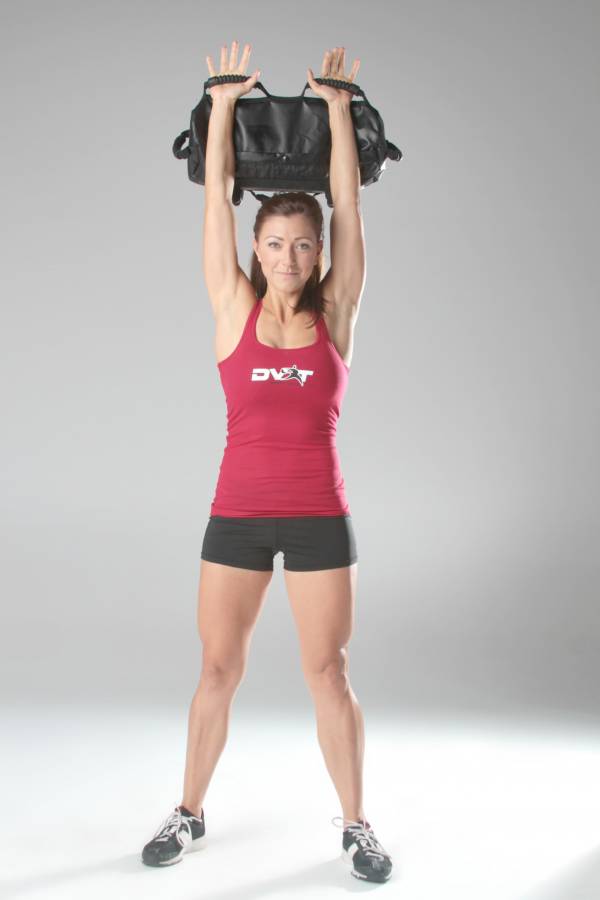If there are two tools that seemed like they were naturally made to be used together it may be kettlebells and sandbags. It isn’t because they are “hardcore,” it isn’t because they are easy to transport, or even relatively easy to learn. There are a lot of commonalities in implementation, benefit, and theory behind each that actually allows them to compliment each other. If you understand how you can put purpose behind meaningful combinations you will be shocked at the synergy of these tools.
If there are two tools that seemed like they were naturally made to be used together it may be kettlebells and sandbags. It isn’t because they are “hardcore,” it isn’t because they are easy to transport, or even relatively easy to learn. There are a lot of commonalities in implementation, benefit, and theory behind each that actually allows them to compliment each other. If you understand how you can put purpose behind meaningful combinations you will be shocked at the synergy of these tools.
While most see kettlebells and sandbags as alternatives to barbell work, there could be nothing further from the truth. Each in their own right is very capable of yielding powerful results and has a much longer history than the barbell. However, many fitness enthusiasts and coaches are stuck looking at everything in fitness as a direct comparison to the barbell. That is why first understanding the uniqueness of these tools is important.
Watch this video, but don’t skip out on reading everything below, as well. There are three workouts provided at the bottom.
Less Spinal Compression
The great benefit of using both these tools is that we don’t see the same axial loading we see in the barbell. Research tells us the majority of people given an MRI will show disc bulges or protrusions. These people will many times be asymptomatic, but they are more prone to have issues, especially when spinal compression is high.
Research shows that when we even half squat with loads of .8-1.6 times our bodyweight, we can experience ten times our bodyweight in spinal compression especially at L3/L4.1 This is also why many coaches tend to favor front squatting compared to back squatting. Which is where kettlebells and sandbags come into play, for this reason and the fact that both tools keep a more upright trunk during squatting – something researchers point to being a key in reducing unnecessary lumbar stress.2
That doesn’t mean these tools can produce the same levels of strength. Placing the weight in front of the body means we change the leverage point of the weight. This actually increases the perceived stress on the body and at lighter loads can activate the same amount of muscles that heavier loads on the back can achieve, except without the higher levels of spinal compression.3
One of the biggest mistakes people make is trying to replicate both front and, unfortunately, back squats with these implements. The reason that back squatting is even possible with the barbell is the fact when a lifter actively sets his or her shoulders, there is a shelf for the barbell to rest upon. With either a kettlebell or sandbag, the arms must extend overhead, taking away any opportunity to create such a shelf. This leads to either the shoulders and/or neck bearing the load or the lifter increasing forward lean and adding to the stress on the lumbar spine. Not to mention, how one could even get appreciable loads in this position with either implement is a high-risk proposition. Moral of the story, keep the loading in the positions we will discuss. If you have your heart set on back squatting, use a barbell.
Let’s see a more practical example in the world of squatting. Using kettlebells and sandbags, we have many more ways to stress the body in the squatting pattern. In fact, a sequence below may be the perfect answer for many training programs. Instead of focusing purely on load, we can challenge the squatting pattern by the position of the weight and how it tries to pull the body out of alignment. As we become more unbalanced with the holding position of the kettlebell or sandbag, the harder our body must work not to just perform a squat, but maintain integrity of the movement.
Stable to Least Stable:
- Double Kettlebell Front Squat
- Sandbag Front Loaded Squat
- One-Arm Rack Squat
- Sandbag Shoulder Squat
How do these variations work? A double kettlebell front squat provides some exposure to squatting with asymmetrical loading. Since the kettlebells are independent implements it stresses the body more than a well-balanced barbell. Moving from the kettlebell double rack front squat to sandbag front-loaded squat places more emphasis on the core to not fall into flexion. Since small changes in placement in load can create profound effects, don’t overlook the simple.
Core Stability
Because kettlebells and sandbags are constantly challenging our postural alignment, the amount of core work being performed ranks right near the top of any form of training. One of the best examples is overhead pressing. I believe overhead pressing to be one of the best measures of core stability. We are not talking about the push press or push jerk, but rather the strict press. What makes the overhead press such an amazing core stability drill?
If we imagine a front plank on the ground and continue to move our arms out in front of us we could see that eventually our arms would end up overhead. Of course, we would be flat on our face, but standing, we replace what gravity provides in loading with actual external load.

Now kettlebells and sandbags offer different ways of stressing what really is an overhead plank. Kettlebells allow unilateral loading which not only stresses the body from front to back, but side to side as well. Being able to train multiple planes of the body at once gives these implements a big boost in the effectiveness department. Sandbags provide a different stimulus in an unstable load. After cleaning a sandbag, the weight may not be evenly dispersed upon the hands, making the body work harder to coordinate the movement. Additionally, as the sandbag is being pressed overhead, the entire body must work as one unit to control the continual shifting and moving of the sandbag.
There are other attributes that kettlebells and sandbags bring that will be in our next installment. In order to show you how simply and powerfully they can be integrated into some workouts I have provided some examples below.
Workout 1
5 sets of 5 reps: 30-45 Seconds Between Sets
Instead of Changing Load, Extend Duration of Pauses and Motion
Alternating Sets:
- Double Rack Kettlebell Front Squats: Set 1 & 2: 5 Second Pause at Bottom, Set 3 & 4: 4 Second Pause at Bottom, Set 5: 3 Second Pause at Bottom
- Sandbag Clean and Press: Set 1 & 2: 5 Second Lowering From Overhead, Set 3 & 4: 4 Second Lowering From Overhead, Set 5: 3 Second Lowering From Overhead
Workout 2
Ladder
3-4 Rounds
5/3/1
Alternating Sets:
- Kettlebell Seesaw Press
- Sandbag Shoulder Squats (Switch Sides Every Time)
Workout 3
30:30 Second Intervals
10 Rounds:
- Kettlebell One-arm Clean and Press (alternate arms every set)
- Sandbag Front Loaded 1 ¼ Squats
To learn more about how kettlebells and sandbags can complement each other within an exercise progression, read Josh’s article 3 Unique Kettlebell and Sandbag Exercise Progressions.
References:
1. Cappozzo A, Felici F, Figura F, Gazzani F. Lumbar spine loading during half-squat exercises. Med Sci Sports Exerc. 1985 Oct;17(5):613-20.
2. Russell PJ, Phillips SJ. A preliminary comparison of front and back squat exercises. Department of Physical Education, University of Maryland, College Park 20742.Research Quarterly for Exercise and Sport [1989, 60(3):201-208]
3. Gullett, Jonathan C; Tillman, Mark D; Gutierrez, Gregory M; Chow, John W. A Biomechanical Comparison of Back and Front Squats in Healthy Trained Individuals. Journal of Strength & Conditioning Research:January 2009 – Volume 23 – Issue 1 – pp






